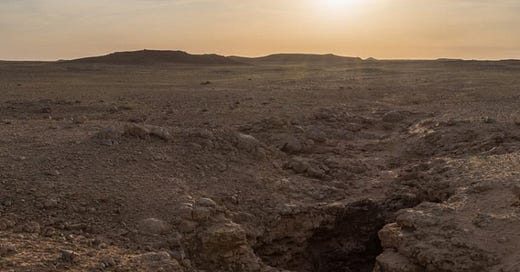Tyneside team unearths evidence of a green Arabian desert
Experts from Northumbria University reveal a rainy days Sahara past. Tony Henderson reports
Investigations led by Tyneside scientists have revealed that one of the most notable desert areas on Earth enjoyed periods of green, humid weather.
The research team into the now dry and arid Saharo-Arabian desert region included lead study author Dr Monika Markowska, and Dr Ashley Martin from Northumbria University.
Supported by the Saudi Heritage Commission and the Saudi Ministry of Culture, the team made the discovery after using cave mineral deposits, such as stalactites and stalagmites, to reconstruct a detailed climatic record
While previous studies suggested that this arid landscape had been in place for at least 11 million years, the new evidence challenges this view, showing that Arabia was a much wetter place during certain periods in history.
These wetter conditions would have enabled the movement of mammals and other species, which relied on water sources for survival.
The record revealed multiple phases of humid weather in the central Arabian region, suggesting the climate was a lot wetter in the past than it is today.
These episodic humid intervals, which occurred throughout the past eight million years, were characterised by higher rainfall, which supported a rich diversity of water-dependent life.
The researchers believe these conditions were caused by tropical precipitation from the south reaching further north in the summer seasons.
Dr Markowska, a Royal Society senior research fellow in Northumbria University’s Department of Geography and Environmental Sciences, also leads a Royal Society University Research Fellowship exploring how dryland landscapes respond to a changing climate.
She said: “I am particularly passionate about improving our understanding on how fragile and vulnerable dryland landscapes will respond to future climate change.
“Historically, the dry conditions of the Saharo-Arabian Desert have been proposed as a significant barrier to the dispersal of plants, animals, and early humans between Africa and Eurasia, but these findings shed new light on this hitherto unrecognised but important crossroad between Africa and Eurasia.
“Our findings highlighted that, as the monsoon’s influence weakened over time, precipitation during humid intervals decreased and became more variable.
“This coincided with enhanced polar ice cover over the Northern hemisphere. Our research is one of the longest terrestrial records ever published.”
Faisal al-Jibrin, lead Saudi archaeologist of the Heritage Commission, said “Arabia has traditionally been overlooked in Africa-Eurasia dispersals, but studies like ours increasingly reveal its central place in mammalian and hominin migrations.”






